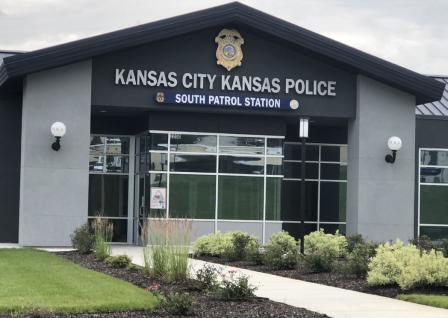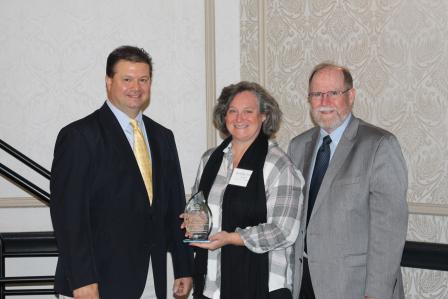What's New in Superfund Redevelopment
You may need a PDF reader to view some of the files on this page. See EPA’s About PDF page to learn more.
Site-Specific News
 A Kansas City Kansas Police Station at the Kansas City Structural Steel site.EPA conducts short-term cleanups – called removal actions – to protect human health and the environment. This case study looks at sites in the Kansas City metropolitan area where removal actions have tackled environmental hazards and protected public health. It shows how these sites can continue to be important assets in communities – and that consideration of reuse and continued use is a key part of cleanup planning and implementation.
A Kansas City Kansas Police Station at the Kansas City Structural Steel site.EPA conducts short-term cleanups – called removal actions – to protect human health and the environment. This case study looks at sites in the Kansas City metropolitan area where removal actions have tackled environmental hazards and protected public health. It shows how these sites can continue to be important assets in communities – and that consideration of reuse and continued use is a key part of cleanup planning and implementation.
Protecting Public Health Through Time-Sensitive Cleanups: Cleanup, Redevelopment and Continued Used of Removal Action Sites in the Kansas City Metropolitan Area (PDF)(13 pp, 3.1 MB)
 Local residents now enjoy a half-mile recreational trail that crosses a cleaned-up site in Pennsylvania.
Local residents now enjoy a half-mile recreational trail that crosses a cleaned-up site in Pennsylvania.
Recreational redevelopment at two cleaned-up Superfund sites is providing expanded recreational opportunities – athletic fields, walking trails, disc golf courses, playgrounds and more. The estimated benefits include $275,000 a year in medical cost savings, over $2 million in increased property values and $238,000 a year in recreational value.
Recreational Reuse and the Benefit to Community: Recreational Redevelopment at Superfund Sites (PDF)(9 pp, 2.4 MB)-
The former Whitmoyer Laboratories site has been cleaned up and redeveloped to provide much-needed recreational amenities for the community, including soccer and baseball fields, a disc golf course and a walking trail. Recreational redevelopment at the site is estimated to boost nearby property values by over $700,000, help save $138,000 a year in medical costs, and provide at least $137,000 in recreational value per year.
Recreational Reuse and the Benefit to Community: A Beneficial Effects Economic Case Study for the Whitmoyer Laboratories Superfund Site (PDF)(13 pp, 5.8 MB) -
Cleanup of the Lipari Landfill Superfund site in the borough of Pitman, New Jersey, has enabled the restoration of recreational amenities to the historic Alcyon Lake and Alcyon Park areas. Recreational redevelopment at the site is estimated to boost nearby property values by over $1.4 million, help save $138,000 a year in medical costs, and provide at least $100,000 in recreational value per year.
Recreational Reuse and the Benefit to Community: A Beneficial Effects Economic Case Study for the Lipari Landfill Superfund Site (PDF)(19 pp, 5.3 MB) -
The Colorado Smelter Superfund site is an example of how EPA can work with local, state and federal partners to sustain residential property values during investigation and cleanup. Superfund designation can help increase property values by promoting greater understanding and certainty around concerns of safety and liability, as well as help focus cross-agency resources on neighborhood revitalization and other needs outside the scope of the cleanup.
Reducing Lending Challenges During Residential Cleanups: The Colorado Smelter Superfund Site Case Study (PDF)(46 pp, 3.8 MB)
Program Related News
- Opportunity Zones are a powerful way to encourage revitalization in economically distressed communities. Redevelopment of current or former Superfund sites may qualify for Opportunity Zone tax benefits. Superfund Redevelopment Program’s new fact sheet provides information on using Opportunity Zone tax incentives for Superfund site redevelopment.
Superfund Redevelopment Using Opportunity Zone Tax Incentives (PDF)(2 pp, 1.8 MB)
- Alternative energy resources can help communities create jobs and diversify local economies. They are also an important part of America’s energy security and environmental sustainability. The Alternative Energy Projects at Superfund Sites: Status Update and Highlights from Across the Country, September 2019 (PDF)(4 pp, 793 K) has been updated, and summarizes the number of Superfund sites currently supporting alternative energy projects, their installed capacity and estimated annual output. For more information, see Alternative Energy at Superfund Sites.
 EPA’s Frank Avvisato (left) and Jim Woolford (right) with Oregon Department of Environmental Quality award recipient Jeannette Acomb (Source: ASTSWMO).Congratulations to the Minnesota Pollution Control Agency, the Oklahoma Department of Environmental Quality and the Oregon Department of Environmental Quality on being 2019 recipients of EPA’s State Excellence in Supporting Reuse Award! This award is given annually in recognition of state partners whose work enhances community quality of life, ensures the long-term protectiveness of site remedies, supports long-term stewardship of the environment, and facilitates safe and beneficial redevelopment and community revitalization.
EPA’s Frank Avvisato (left) and Jim Woolford (right) with Oregon Department of Environmental Quality award recipient Jeannette Acomb (Source: ASTSWMO).Congratulations to the Minnesota Pollution Control Agency, the Oklahoma Department of Environmental Quality and the Oregon Department of Environmental Quality on being 2019 recipients of EPA’s State Excellence in Supporting Reuse Award! This award is given annually in recognition of state partners whose work enhances community quality of life, ensures the long-term protectiveness of site remedies, supports long-term stewardship of the environment, and facilitates safe and beneficial redevelopment and community revitalization.

